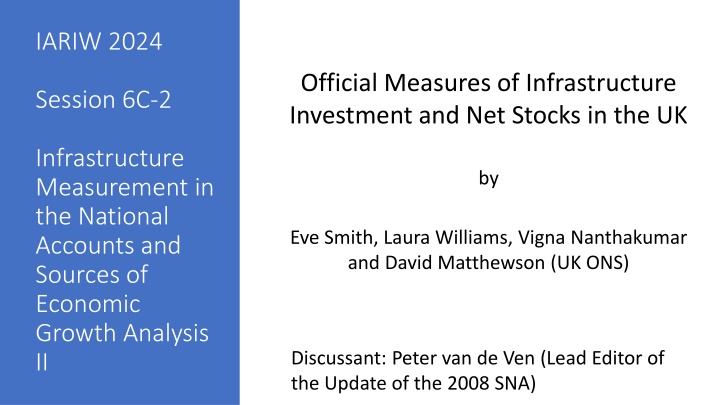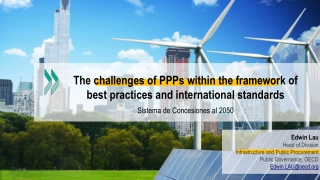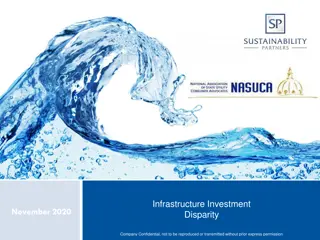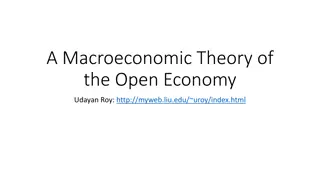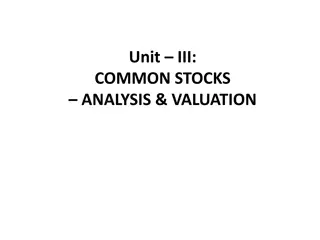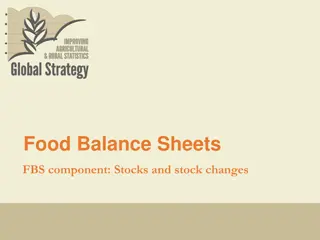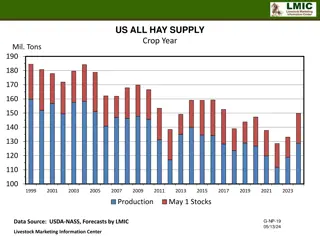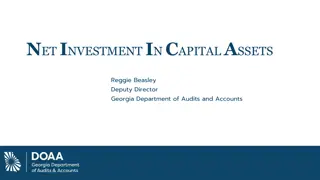Measures of Infrastructure Investment and Net Stocks in the UK: Insights and Trends
This research delves into infrastructure investment and net stocks in the UK, highlighting the importance of infrastructure for economic growth. It explores the development of extended measures, including digital infrastructure, and research related to flood defenses. The UK National Infrastructure Commission's perspective, ONS's operationalization of infrastructure, and the latest findings on market sector investments and government investments are also discussed. The report provides a comprehensive overview of infrastructure measurement and publication practices.
Download Presentation

Please find below an Image/Link to download the presentation.
The content on the website is provided AS IS for your information and personal use only. It may not be sold, licensed, or shared on other websites without obtaining consent from the author.If you encounter any issues during the download, it is possible that the publisher has removed the file from their server.
You are allowed to download the files provided on this website for personal or commercial use, subject to the condition that they are used lawfully. All files are the property of their respective owners.
The content on the website is provided AS IS for your information and personal use only. It may not be sold, licensed, or shared on other websites without obtaining consent from the author.
E N D
Presentation Transcript
IARIW 2024 Official Measures of Infrastructure Investment and Net Stocks in the UK Session 6C-2 Infrastructure Measurement in the National Accounts and Sources of Economic Growth Analysis II by Eve Smith, Laura Williams, Vigna Nanthakumar and David Matthewson (UK ONS) Discussant: Peter van de Ven (Lead Editor of the Update of the 2008 SNA)
Measures of Infrastructure Investment and Net Stocks in the UK Summary of past research Development of extended measures, to include digital infrastructure Research into infrastructure related to flood defences Considered important to have more detailed insights, because infrastructure increases productivity through reducing the costs of production, reducing barriers to trade, increasing competition through opening up markets and widening the pool of labour from which firms can choose. Conversely, the weakening of an economy s infrastructure is likely to have a negative impact on productivity: raising the costs of production, reducing the efficiency of trading relationships and limiting market access . Objectives of the research
UK National Infrastructure Commission: The basic physical and organisational structures and facilities (for example, buildings, roads, power supplies) needed for the operation of a society or enterprise After literature review, the UK ONS operationalized this by taking a functional view of infrastructure and used it to define types of economic infrastructure to form this basis of its reporting Defining infrastructure
ONS has been publishing measures of new investment in infrastructure assets for the UK since 2017, and data on stocks since 2018 Time series of investments and capital stocks from 1997 onwards Annual updates, with latest update in July 2024, including estimates up to 2023 (market sector) and 2022 (government) Distinction made between the market sector and the non- market sector (general government), both including various details Estimates in both current prices and in volume terms Latest findings for 2022/2023: Market sector investments: 13.8 billion (in 2021 constant prices), up 3.9% from 2022 Market sector net stocks of infrastructure: 350.2 billion (in 2021 constant prices), up 0.3% from 2022 General government investments: 26.0 billion (in current prices), up 9.6% from 2021 Current state of play regarding measurement and publication
Research by the OECD based on relevant work by countries Proposed OECD-definition of infrastructure much broader: Infrastructure is the set of fundamental facilities and systems that support the provision of goods and services essential to enable, sustain, or enhance societal living conditions and maintain the surrounding environment The set of fundamental facilities and systems are composed of public and private physical structures as well as intellectual property products supporting the effective operation of these structures. Economic infrastructure related to the following functions: transport; utilities (provision of energy, water, and sanitation and waste management); flood protection and water management; and IT and communications Social infrastructure related to the following functions: education; health; public order and safety; culture; and recreation Often public goods or club goods Detailed list of assets provided Defining infrastructure (continued)
Current UK-definition only includes: fibre-optic networks coaxial and copper cables Communication towers Extended to include the following elements, with several refinements: Communications buildings, including cell-towers and data centres Network base stations Broadband access and internet connectivity systems Software to run IT and communications related networks Permits for the use of radio spectra Cables and lines - coaxial, copper, aluminium, etc., optical fibre Other communication construction Estimates have been made for the whole time series, and validated using other sources Plans to include these estimates in the current lead estimates, first as an addendum Also plans to consider the OECD-definition for future work Broadening digital infrastructure
Broadening digital infrastructure
Investment in flood defences is a priority area for environmental policy Not yet comprehensively captured in current investment and stock estimates Conclusion of research paper found that as of May 2023, there is currently a lack of readily available data to create a consistent and coherent time series to illustrate the state of investment in flood defences or alleviation across the four nations of the UK As a result, ONS are not able to incorporate any statistics on the investment in flood defences in its Infrastructure investment and net stocks publication => remains on the research agenda According to The Flood and Coastal Erosion Risk Management (FCERM) risk management report, the economic losses from flooding between November 2019 and March 2020, a period when severe winter flooding occurred across the UK, were about 333 million. However, these losses would have been an extra 2.1 billion without flood defences Measuring flood defences
Forthcoming study will explore Climate Adaptive Infrastructure, referring to a new hybrid approach to infrastructure design and planning that emphasises the urgency of adaption to climate change Use of the OECD s proposed classification, to explore the expansion of its definitions of other economic asset types, including transport, energy and waste Considering expanding the scope to include social infrastructure New case studies on different areas of economic infrastructure, such as on transport infrastructure, infrastructure for UK government net zero targets, sewerage, and energy Assessing the UK s critical minerals infrastructure Improving regional estimates Creating international comparisons Future work
Great work that I welcome very much Flood defences: what is currently (not) included? Very significant agenda for future research: clear need for setting priorities, guided by a longer-term vision => available? Have you ever considered extending the framework beyond the measurement of investments and stocks: (Physical) performance indicators on quantity and quality of capital services provided, such as in the case of transport, ton- miles, person-miles, traffic jams, timeliness of trains, and the like; or indicators like the ones provided by FCERM on flood defences Additional monetary estimates on, for example, maintenance and repairs and other costs, capital services, and finance Discussion
Thank you for your attention!
